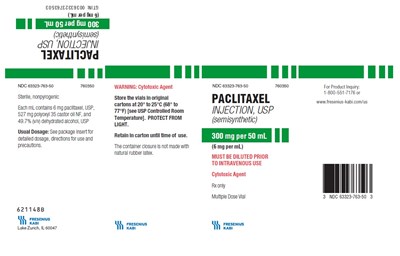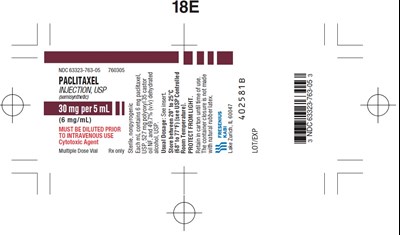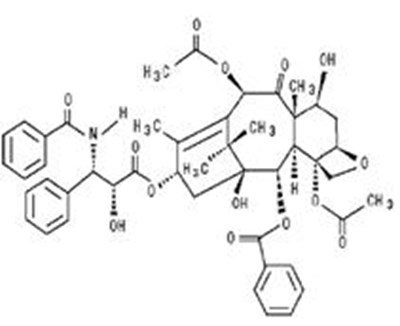Product Images Paclitaxel
View Photos of Packaging, Labels & Appearance
- carton 100mg
- carton 300mg
- carton30mg
- fig-1 - fig 1
- fig2 - fig2
- logo - logo
- paclitaxel-fig3 - paclitaxel fig3
- paclitaxel-fig4 - paclitaxel fig4
- paclitaxel-fig5 - paclitaxel fig5
- paclitaxel-fig6 - paclitaxel fig6
- paclitaxel-fig7 - paclitaxel fig7
- paclitaxel-fig8 - paclitaxel fig8
- paclitaxel - paclitaxel
- vial 100mg
- vial 300mg
- vial 30mg
Product Label Images
The following 16 images provide visual information about the product associated with Paclitaxel NDC 63323-763 by Fresenius Kabi Usa, Llc, such as packaging, labeling, and the appearance of the drug itself. This resource could be helpful for medical professionals, pharmacists, and patients seeking to verify medication information and ensure they have the correct product.
carton 300mg

This text appears to be a description of a medication containing pacitaxel that is categorized as a cytotoxic agent. It is in injection form and is sold in vials with specific dosages, and must be diluted before intravenous use. The vials must be stored between 20 to 25°C and protected from light. The text mentions the inclusion of specific substances in the medication. It also provides a contact number for product inquiries.*
carton30mg

This is a description of Pacitaxel Injection, USP, a sterile and nonpyrogenic solution packaged in vials containing 6 mg of Pacitaxel, USP per mL, along with other ingredients, including polyoxyl 35 castor oil NF and dehydrated alcohol USP. The usual dosage is detailed in the package insert, and the product should be diluted before intravenous use. It is classified as a cytotoxic agent and should be stored in the original carton at controlled room temperature and protected from light. The container closure does not contain natural rubber latex. Contact the manufacturer for further inquiries.*
fig-1 - fig 1

This text seems to be a survival analysis report. It shows the proportion surviving based on the number of events that occurred over a span of 4 years. The HR (hazard ratio) is reported at 0.73 with a 95% confidence interval of 0.60-0.89. There are also tables showing the number at risk and the number of events at different time points. Additional context is required to provide a more thorough description.*
fig2 - fig2

This is a survival plot showing the proportion surviving for patients receiving Cc versus Tc in a clinical trial called GOG-111. The plot shows the number of patients, number of events, hazard ratio, and the number at risk over time.*
paclitaxel-fig3 - paclitaxel fig3

The text appears to be a graph showing disease-free survival rates of two different treatments, AC and AC+T. The graph shows the proportion of patients who remained disease-free over time. The labels on the x-axis suggest that the data is organized by time intervals (08, 06, 04, 02). The graph also includes a table with some statistics comparing the efficacy of the two treatments. The meaning of one label (ACHT) is not clear from the provided text.*
paclitaxel-fig4 - paclitaxel fig4

This is a graph showing the proportion of patients surviving over time for AC (Doxorubicin and Cyclophosphamide) treatment compared to AC+T (Doxorubicin, Cyclophosphamide, and Paclitaxel) treatment. The graph shows the number of patients at risk and the number of events (presumably deaths or disease progression). The hazard ratio (HR) is also reported for the two treatments. The text does not provide any additional information or context.*
paclitaxel-fig5 - paclitaxel fig5

The figure depicts disease-free survival with respect to receptor status (negative/unknown) for two chemotherapy treatments, namely AC and AC+T. The number of events, hazard ratio, and number of risk are also provided for each treatment arm.*
paclitaxel-fig6 - paclitaxel fig6

This is a graph (Figure 6) showing the disease-free survival of patients with positive receptor status who received AC (a chemotherapy regimen) versus those who received AC+T (another chemotherapy regimen). The graph includes the number of events (149 for AC and 144 for AC+T), hazard ratio (0.92), and the number of patients at risk over time (at years 1, 2, 3, and 4).*
paclitaxel-fig7 - paclitaxel fig7

The text describes results from a study, with Figure 7 showing a comparison of disease-free survival between two treatments - premenopausal AC and AC+T. There is information on hazard ratio (HR) and the number of individuals at risk for each treatment. However, there is no clear information on the exact units of time or outcome measure used to calculate disease-free survival.*
vial 100mg

This is a description of a multiple dose vial for a cytotoxic agent called paclitaxel, to be diluted before intravenous use. It contains 100mg per 16.7mL, with a concentration of 6mg per mL. The product is identified by an NDC code of 63323-763-16.*
vial 300mg

This is a description of a medicine called 'PACLITAXEL', which is a cytotoxic agent, that needs to be diluted before intravenous use. It comes in a multiple dose vial with 300mg per 50ml (6mg/mL) injection. The medicine is semi-synthetic and has an NDC code of 63323-763-50.*
vial 30mg

This appears to be a label for the drug PACLITAXEL, which is a cytotoxic agent used for intravenous injection. It is important to dilute the drug before use. The drug comes in a multiple dose vial containing 30mg per 5, and the NDC (National Drug Code) is 63323-763-05. The label also includes some numerical codes and characters, but their relevance is unclear without additional context.*
* The product label images have been analyzed using a combination of traditional computing and machine learning techniques. It should be noted that the descriptions provided may not be entirely accurate as they are experimental in nature. Use the information in this page at your own discretion and risk.



